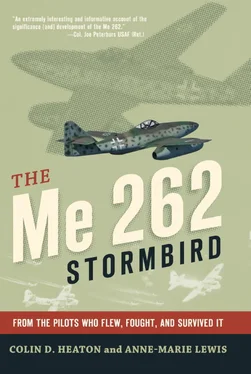“Then I thought about it, as I looked at his Knight’s Cross, and then I felt my own. ‘You know, there is enough silver in one Knight’s Cross to probably fix three or four jets.’ Galland looked at me, and smiled. He was very funny and said, “All right, I will call Berlin and tell Milch that we should stop making the medals and use that for the rockets, and also while I am at it, have them melt down anything already made for the production line.’ I liked the idea, but Galland said no, as it would be a waste of time. Well, we knew what to look for on the rocket pods, and we had the chiefs use solder to reinforce the connections on every aircraft with what silver or nickel we could find. They worked well after that, being more reliable.” {3}
Messerschmitt and the other various companies that brought the Me 262 to life all read the reports that reached them, and in most cases, they took corrective action, such as with the enlarged vertical and horizontal stabilizers and tail assembly, and solving landing gear problems. The one test jet that finally incorporated all of these drastic changes was Me 262V10, coded as VI+AE with work number 130005.
This aircraft was the one design that was a response to Wolfgang Schenck’s issues while using the jet as a fighter-bomber. Part of the problem was the issue of pilot control at high speeds while at low altitude, where drag was increased due to thicker and warmer air, thus increasing the pressure as experienced by Kommando Schenck pilots, as well as those in KG-51 “Edelweiss,” which was formed in July 1944 and commanded by Oberstleutnant Wolf-Dietrich Meister until he was succeeded by Major Wolfgang Schenck on December 5, 1944; pilots in KG-54, originally a Ju-88 bomber unit commanded by Oberstleutnant Baron Volprecht Riedesel Freiherr von zu Eisenbach until he was killed in action on February 9, 1945, and replaced by Major Hans-Georg Bättcher, and even the training unit of EJG-2 experienced these issues. {4} The secret was in the joystick.
The traditional joystick that frequently became sluggish or even nonresponsive in previous Me 262 versions was modified. Along with the increased control surfaces and streamlined canopy, the new joystick was built with the sealed ball bearing gearbox encased in lubricant fluid, which was a combination of ethylene glycol and petroleum distillate. This design provided lubrication and reduced friction while preventing the mixture from congealing at low temperatures while operating at subfreezing altitudes.
The design and corrective action of the airframe was a much easier process than solving the engine issues. The swept wing design of the Me 262 was actually too shallow to achieve any significant aerodynamic advantage without an accompanying powerplant to compensate for the weight. What made the difference was the actual angle of the wing surface reducing drag while achieving lift. The lift-to-weight ratio was critical with jet power, as the Germans quickly learned. This was especially true once bombs and rockets were attached. Therefore, to achieve universal harmony and aerodynamic stability, the wing was repositioned slightly aft of the original design.
Following Schenck’s recommendations further, this variant was also tested for an increased bomb load and expanded fuel capacity during trials in May 1944. The hope was to fulfill Hitler’s demand to have a “blitz bomber” with enough punch and range to be effective, as stated by Generalmajor Dietrich Pelz:
“The Me 262 bomber idea was, of course, all Hitler’s idea. I supported it, until I examined the Ar 234. But, I also knew that it would take more time to modify existing 262s to fit this role than it would be to simply build them at the various factories and roll them out already configured for this work. It was a matter of time and money, but mostly it was just simple logic. I was interested to see what they would come up with.” {5}
Gerd Lindner flew the new test version of the jet bomber, using the new bomb release mechanism—the bombs on each wing were mounted to a trolley that would be released when he detonated a small charge. The high-speed dive resulted in one bomb falling away while the other was still attached under the wing. Schenck had made a valid argument.
Lindner also tested the later variants to emerge from the Messerschmitt works, such as the Me 262, V167, work number 130167, which was to test the newer rudder assembly and flight stability. Baur, Wendel, Hans Herlitzius, and others flew newer and renovated designs. (For more on this subject, Morgan’s book is highly recommended.) All of their efforts were to prove valuable in the field, yet too late to really make any difference for the Luftwaffe .
After thousands of man-hours and trial and error, the airframe issues had been largely resolved, but the powerplants still had issues; by late June 1944, the Jumo 00484 emerged with an average estimated operational life span of approximately twenty-five hours. However, these estimates were conducted on static tests and controlled test flights—not conducted under combat conditions. According to Johannes Steinhoff: “I was the technical officer for a while with JG-7 and then kommandeur , and in that unit if we managed to squeeze ten to fifteen hours out of an engine, we were very lucky. As a safety precaution, it was suggested that engine checks be conducted after every four hours, fan blade checks before and after every mission, and fuel line checks every day.
“Usually when an aircraft is in production, lessons are learned, corrections are made, and the aircraft gets better. This was true in many areas with the Me 262, but the Jumos was not one of them. As the war went on it seemed as if the quality control went right out the window, where mass production seemed to be more important than delivering a quality product. There we were, strapping our asses into a flying coffin, and hoping that our own engines would not fail us, causing us to die. Given that reality, I cannot even imagine how those poor Komet pilots did their job. At least we had a fighting chance if things went wrong.
“When I joined JV-44, the engines on the jets, even new ones, that had been rated for twenty-five hours at the laboratory, and had lasted about fifteen hours in the early production models, now lasted perhaps ten hours. We needed more replacement engines just to keep up the same ratio of sorties to aircraft. This was intolerable, but we had to work with what we had. I spoke with Dolfo about this, and he made an inquiry to Messerschmitt, who was in charge of design and production. I recall Galland saying that Prof. Messerschmitt had no control over what Junkers was sending him. He could only put them together.
“This was also an unacceptable condition, so Galland paid a visit to Milch at some point, right before our first large-scale operational mission as an official unit. I am not aware of the details of that meeting, but I do know that Galland said that we were pretty much screwed, and had to work with whatever they sent us. This was not the most comforting thing to have in the back of your head when climbing into the cockpit. I know that every pilot was watching the clock when it came to how many hours his engines had been used. [Eduard] Schallmoser once said that he was better off ramming his jets into enemy aircraft, because it was easier to get a new complete jet than it was to get a complete replacement engine that lasted long enough. His logic may have been twisted, but it made sense. You sort of had to be there in order to appreciate the irony.” {6}
Wolfgang Späte also commented on the dangers of losing an engine in combat, as stated in his own book, Top Secret Bird , when referring to the Me 262 and the Jumo 004 engines: “Frequently, after an Me 262 hit an enemy aircraft and flew through the wreckage, an engine would flame out because of damage to the compressor. In that situation, there was nothing else for the Me 262 pilot to do except to break off the engagement and head home. Then the pilot had to make sure that he didn’t meet up with a Mustang or Thunderbolt.
Читать дальше












